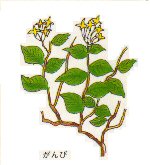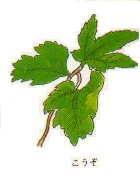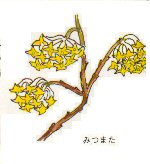The Izumo region, in the West part of Japan, has been documented as a paper production area since ancient times.
Former Living National Treasure Eishirou Abe built upon this local tradition, and with the counsel of the founder of the Folkcraft Movement Soetsu Yanagi, established Izumo Folkcraft Paper.
Currently, the spirit and skill of Eishirou Abe has been passed to his grandsons, Shinichirou and Norimasa Abe.
Shimane Prefecture designated Intangible Cultural Asset
Shinichirou Abe
Shimane Prefecture, Matsue, Yakumo , Higashi-Iwasaka
690-2102
TEL 0852-54-0303
Eishirou Abe was born on January 14, 1902 in Yakumo Village, Yatsuka County, Shimane Prefecture. His family's livelihood was papermaking and Mr. Abe became involved at an early age. Since Yakumo was not a major papermaking center with high technical standards, Mr. Abe determined to study the techniques of papermaking at a professional institute, and at the age of 21 entered the papermaking division of the Shimane Prefectural Industrial Laboratory. Here, he experimented with different papermaking methods, and perfected his technique. Later, he would be appointed as an adviser to the papermaking craftsmen in Shimane Prefecture.
In 1931, Soetsu Yanagi, the founder of Japan's Folkcraft Movement, was greatly impressed when he saw Mr. Abe's work in Matsue, the capital city of Shimane Prefecture. Mr. Yanagi said of Mr. Abe's Gampi paper: "This is the paper of Japan," and thus began Mr. Abe's long involvement in the Folkcraft Movement. His lifelong dedication to Washi was greatly inspired by the work of fellow artisans from diverse crafts, such as textile weaving and dyeing, ceramics, and woodblock printmaking.
He created dyed handmade papers (Wazomegami), elaborately patterned papers (Sukimoyoshi), and papers which emphasize the simple, natural beauty of Kozo, Mitsumata, and Gampi fiber (Kizukigami). These papers are collectively called "Izumomingeishi", the folkcraft paper of the Izumo Region, and have attracted many folkcraft lovers from across Japan, and around the world.
From 1960, Mr. Abe was a member of the 3-year Shosoin paper survey group, along with other scholars such as Professor Bunsho Jugaku, a well known scholar of Washi. The group conducted studies of Japanese handmade papers from the late Nara Period (710-784), which are stored at the Shosoin Imperial Treasure Repository. These studies led Mr. Abe to recreate the ancient Washi using original papermaking methods.
In 1968, the Agency for Cultural Affairs of Japan's Ministry of Education designated Mr. Abe as a "Living National Treasure of Japan" for his traditional Gampi papermaking techniques, which had already been designated an "Important Intangible Cultural Asset". Three other Japanese papermaking techniques were also designated as "Important Intangible Cultural Assets": Sekishu hanshi (Shimane Prefecture), Honminoshi (Gifu Prefecture), and Hosokawashi (Saitama Prefecture).
In 1934, Mr. Abe had a one-man exhibit of his papers in Tokyo. This was the first one-man show in the history of Japanese handmade papers. From this time until his death on December 18, 1984, Mr. Abe had shows every year. Through these shows, the public was reintroduced to the independent beauty and depth of Washi; Washi is not simply a medium for other arts, but in itself represents original beauty, and also has the capability to express personal skill, local character, and traditional values. Mr. Abe became known not only in Japan but throughout the world (between 1974 and 1980, one-man shows were also held in Paris, New York, Los Angeles, San Francisco, and Peking).
In 1983, Mr. Abe established "Abe Eishirou Memorial Hall", where a wide and varied collection of literature and materials related to Washi, and many items made of Washi are exhibited. Next to the Hall is the Washi Denshusho Hall where individuals can personally experience the Japanese handmade papermaking process.
1- The bark of various small trees is used for papermaking. The trees are cut, the branches are steamed, and the bark is stripped away from the woody core. The outer black bark is scraped away with a knife, and it is the inner layer of white bark that is dried and stored for later use. When it is time to make paper, the white bark is soaked in water overnight, and debris and scars are removed with a knife. Approximately 3 of the strips of bark go into making one sheet of paper. Izumo Mingeishi studio uses about 4 metric tons of this
2- The bark is boiled in a pot with a mild caustic such as soda ash, until it becomes soft.
3- Cooking residue is removed by rinsing the bark in running water, and unwanted debris is painstakingly removed by hand. Throughout the papermaking process, the quality of the water is very important; if clean, clear water is not used, the fiber can spoil easily, and good quality paper cannot be made.
4- The bark is beaten, either with a foot-powered stamper type beater or in a machine called a Hollander beater (or sometimes both), breaking it down into individual fibers.
5- The beaten fiber is put in a vat with water, and "neri" is added. Neri is a liquid extracted from the roots of the Tororo Aoi plant. Sheets are made by scooping into the solution with a bamboo screen (su) which is laid across a wooden frame (keta). The sheets are transferred off of the screen into a pile, directly one on top of the other. In a day's work, approximately 250 sheets can be made. Making the sheets all to the same thickness is accomplished according to the craftsman's sensibilities, achieved over many years of experience.
6- The paper sheets at this point are mostly water, and so the stack of paper is pressed to remove most of the water.
7- The pressed paper is brushed sheet by sheet, either onto wooden boards and dried in the sun, or onto a steam-heated sheet-metal dryer.
In Japanese papermaking, a wide variety of fibers are used, but originally, fibers such as hemp, kozo, and gampi were prevalent. During the Edo period (1600-1868), mitsumata began to be used, and currently, kozo, mitsumata and gampi have become the typical fibers used for Japanese papermaking. Other suitable fibers for papermaking include straw, kuwa, bamboo, and wood pulp. Also, in recent years, the use of imported Thai kozo, Philippine gampi, and Manila Hemp (Abaca) is increasing.

Two species of Gampi are used to make Washi: Gampi (Diplomorpha Sikokiana Honda) and Ao-Gampi (Wikstroemia Retusa A. Gray). The average length of Gampi fiber is about 3 millimeters. These fibers are translucent, glossy and somewhat sticky, making Gampi papers glossy and tough. They have good wet strength and an inherent resistance to insects.

The fibers from Kozo (Broussonetia Kazinoki Sieb) are about 10 millimeters in length. By way of comparison, the length of wood pulp fibers is only about one millimeter. Kozo fibers are durable, and intertwine easily so that kozo papers retain their strength even when crumpled or folded. At the present time, kozo is the most widely used fiber for Japanese handmade paper.

Mitsumata (Edgeworthia Chrysantha Lindle) fibers are about 4 millimeters in length. Their strength is slightly less than that of Gampi or Kozo, but they are finer and more flexible, with a glossy appearance. Mitsumata papers have a soft, smooth surface, with an elegant gloss, and are insect-resistent like Gampi papers. Because of their smooth surface, they are often used for Japanese calligraphy and for fine printing.